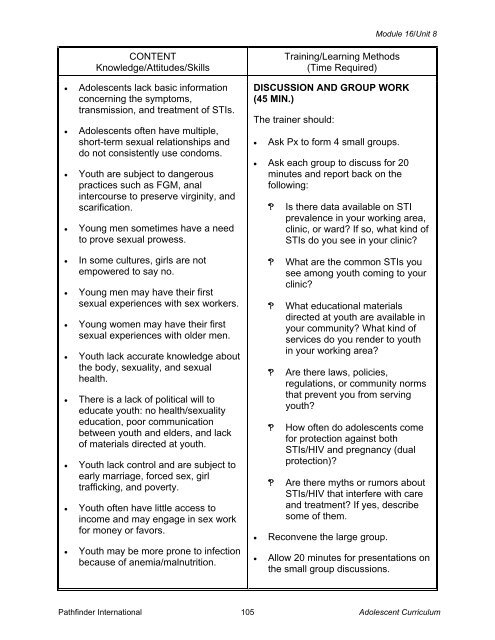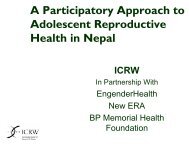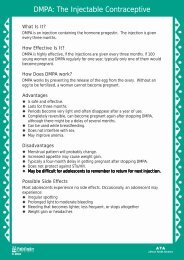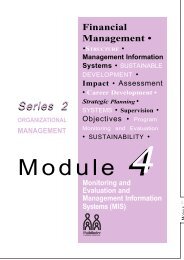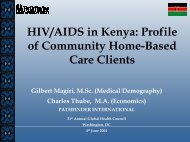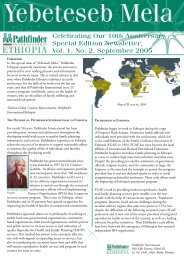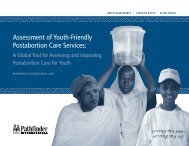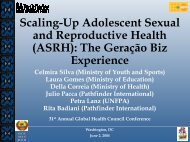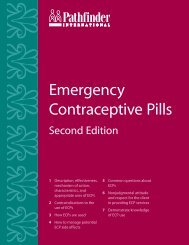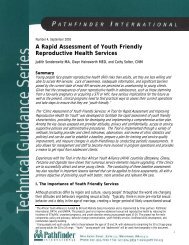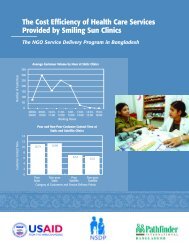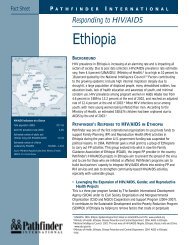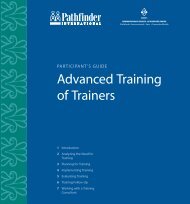reproductive health services for adolescents - Pathfinder International
reproductive health services for adolescents - Pathfinder International
reproductive health services for adolescents - Pathfinder International
Create successful ePaper yourself
Turn your PDF publications into a flip-book with our unique Google optimized e-Paper software.
Module 16/Unit 8<br />
CONTENT<br />
Knowledge/Attitudes/Skills<br />
• Adolescents lack basic in<strong>for</strong>mation<br />
concerning the symptoms,<br />
transmission, and treatment of STIs.<br />
• Adolescents often have multiple,<br />
short-term sexual relationships and<br />
do not consistently use condoms.<br />
• Youth are subject to dangerous<br />
practices such as FGM, anal<br />
intercourse to preserve virginity, and<br />
scarification.<br />
• Young men sometimes have a need<br />
to prove sexual prowess.<br />
• In some cultures, girls are not<br />
empowered to say no.<br />
• Young men may have their first<br />
sexual experiences with sex workers.<br />
• Young women may have their first<br />
sexual experiences with older men.<br />
• Youth lack accurate knowledge about<br />
the body, sexuality, and sexual<br />
<strong>health</strong>.<br />
• There is a lack of political will to<br />
educate youth: no <strong>health</strong>/sexuality<br />
education, poor communication<br />
between youth and elders, and lack<br />
of materials directed at youth.<br />
• Youth lack control and are subject to<br />
early marriage, <strong>for</strong>ced sex, girl<br />
trafficking, and poverty.<br />
• Youth often have little access to<br />
income and may engage in sex work<br />
<strong>for</strong> money or favors.<br />
• Youth may be more prone to infection<br />
because of anemia/malnutrition.<br />
Training/Learning Methods<br />
(Time Required)<br />
DISCUSSION AND GROUP WORK<br />
(45 MIN.)<br />
The trainer should:<br />
• Ask Px to <strong>for</strong>m 4 small groups.<br />
• Ask each group to discuss <strong>for</strong> 20<br />
minutes and report back on the<br />
following:<br />
Is there data available on STI<br />
prevalence in your working area,<br />
clinic, or ward If so, what kind of<br />
STIs do you see in your clinic<br />
What are the common STIs you<br />
see among youth coming to your<br />
clinic<br />
What educational materials<br />
directed at youth are available in<br />
your community What kind of<br />
<strong>services</strong> do you render to youth<br />
in your working area<br />
Are there laws, policies,<br />
regulations, or community norms<br />
that prevent you from serving<br />
youth<br />
How often do <strong>adolescents</strong> come<br />
<strong>for</strong> protection against both<br />
STIs/HIV and pregnancy (dual<br />
protection)<br />
Are there myths or rumors about<br />
STIs/HIV that interfere with care<br />
and treatment If yes, describe<br />
some of them.<br />
• Reconvene the large group.<br />
• Allow 20 minutes <strong>for</strong> presentations on<br />
the small group discussions.<br />
<strong>Pathfinder</strong> <strong>International</strong><br />
105<br />
Adolescent Curriculum


